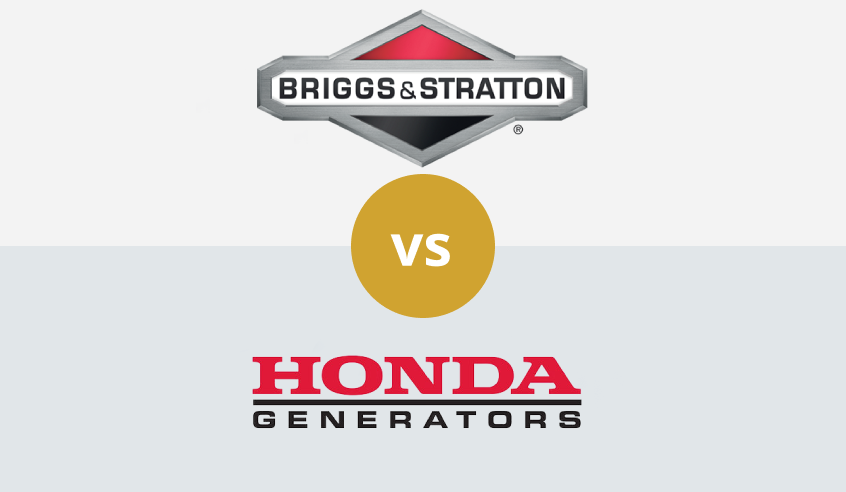
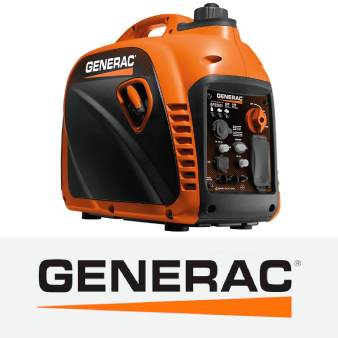
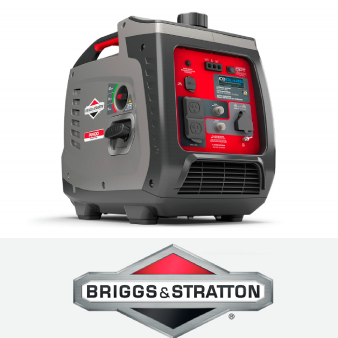
Both Generac and Briggs & Stratton always feature among the top home generator brands with their products battling for supremacy in the consumer market. Some of these products include the Generac 7117 Gp2200I Portable Generator and the Briggs & Stratton P2400, which are intended for the same consumer base. The two inverter generators offer a portable clean energy solution for anyone using the devices at home or taking them out for an outdoor tailgating experience. However, you can only pick one. So, Generac vs Briggs and Stratton generator: which is better? The answer may be different depending on your circumstances and intended use. That said, the review of the two options compared to each other below should certainly come in handy in helping you decide.
Briggs and Stratton Trusted Source History of the Lawn Mower | Briggs & Stratton From steam powered lawn mowers to modern gas powered engines, the lawn mower have come a long way. Learn about its evolution! www.briggsandstratton.com had a few decades’ heads start over Generac after having been founded in 1908 in Milwaukee, Wisconsin, through a partnership between Stephen F. Briggs and Harold M. Stratton, hence the name. However, most of its generator offerings in the early years were mostly for agricultural and military applications.
On the other hand, despite being founded in 1959, Generac Trusted Source Generac Power Systems - Job Openings, Community Involvement, and More About Us Search job openings, find out what’s new, download brochures, and more about Generac Power Systems. www.generac.com ’s business model featured a different approach which involved offering affordable home standby generators.
Since then, both manufacturers have made huge strides in the home generators business and are now mostly comparable. As such, it’s easy to find one person swearing by the Generac brand while another swears by Briggs and Stratton generators.
The one thing that is distinctly different between the two brands is the design. Generac generators are typically colored orange and black. Conversely, Briggs and Stratton generators have a grey, black, and red design with a few exceptions, such as in the Briggs & Stratton P2400.
With regard to features, the two manufacturers trade blow for blow with competing models, with no clear winner between the two.
| Generac 7117 Gp2200I | Briggs & Stratton P2400 | ||
| Type | inverter | inverter | |
| Peak Watts | 2200 | 2400 | |
| Rated Watts | 1700 | 1800 | |
| Engine | OHV, 80cc | 4-stroke OHV, 79cc | |
| Fuel Tank Capacity | 1.2 gallon | 1 gal. | |
| Runtime | 10.75 hrs @ 1/4 load | 8 hrs @ 1/4 load | |
| Outlets | (1) 120V, 20A 5-20R Duplex, (1) 5VDC USB, (1) 12 VDC | (2) 230V 16 Amp, (1) 12V 5 Amp DC, (2) USB | |
| Start Type | recoil | recoil | |
| Dimensions | 19.7 x 11.4 x 17.9 in. | 20.04 x 12.24 x 17.36 in. | |
| Weight | 46.6 lbs. | 50 lbs. | |
| Warranty | 2 years (residential), 1 year (commercial) | 3 years | |
| VIEW ON AMAZON | VIEW ON AMAZON |
Both the Generac 7117 Gp2200I and the Briggs & Stratton P2400 are compact inverter generators from their respective manufacturers designed for outdoor use. As such, they make great generators for camping, tailgating, and other outdoor events. However, if you’re looking for the best inverter generators for other uses, our list of the best inverter generators on the market may come in handy.
Nevertheless, both the Generac 7117 Gp2200I and Briggs & Stratton P2400 can also be used to charge devices at home in case of a power outage. They feature fairly similar engines, although there is a difference in power output. However, the design, power outlets, size, and weight differences may affect your final purchase decision. For more details, keep reading.
With regard to the engines, the Briggs & Stratton P2400 model features a 4-stroke 79 cc overhead valve engine with a peak 2400-watt output. However, its running wattage is capped at 1800 watts which you need to consider when plugging in your electronic appliances.
The Generac model features an overhead valve engine rated at 80cc. That said, its starting wattage maxes out at 2200 watts. As such, if your appliances require more power, the Briggs & Stratton model may be a better pick. The Generac generator also loses out in terms of running wattage with its maximum output at 1700 watts.
Both are manual start generators, so you’ll need to pull the recoil on each to start the engine. However, they should both start easily so long as there’s enough fuel and you have the starting dial in the correct position.
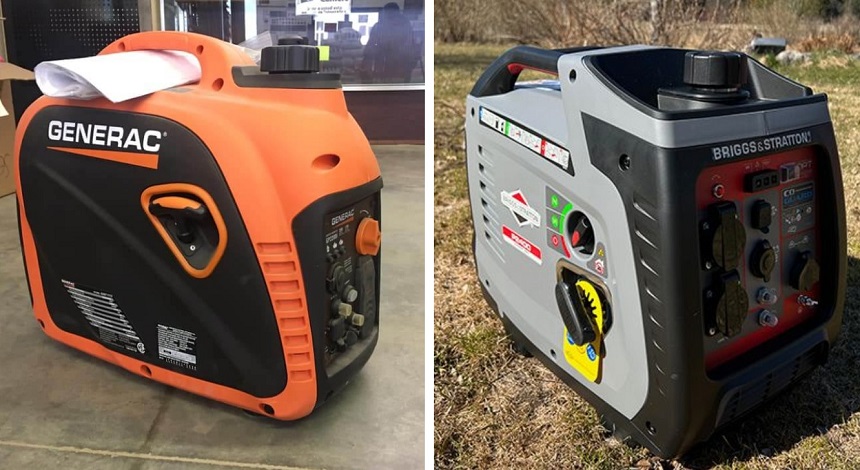
The Briggs & Stratton inverter generator is a gas-powered model with a one-gallon fuel tank. You’ll have to remove the cover on the side and the fuel cap before you can refuel. Also, a full tank will last about 8 hours of running time on a ¼ load.
The Generac inverter generator is also gas-powered, and despite its seemingly smaller form factor, it comes with a larger 1.2-gallon fuel tank. This is one of the reasons why it can go for up to 10.75 hours on ¼ load if the tank is full.
With the respective runtimes provided by the two generators on a full tank, both options are fairly fuel efficient. However, users can get even more fuel efficiency out of their generators depending on how they use them. With the Generac 7117 model, for instance, you get an economy mode button.
Activating economy mode will automatically adjust the engine speed to work according to the load. As such, if you’re only charging your low-power devices, the engine will adapt and use less fuel. This can result in more fuel savings, longer runtimes, and even quieter running.
Its counterpart, the Briggs & Stratton P2400, also seems to offer something similar in its Quiet Power Technology. When you turn the switch on, the engine speeds will vary according to the load. If the load is high, the engine may run a little faster and louder. Conversely, if the load is low, the machine will adapt, and the engine will run slower and quieter, saving more fuel in the process.
The Briggs & Stratton model takes the cake where safety features are concerned. This is due to the inclusion of carbon monoxide shutdown technology. Burning the fuel required to run the generator releases carbon monoxide, which can be hazardous. It’s recommended that you run the generator outdoors, so you don’t get carbon monoxide poisoning.
Nevertheless, if for some reason you run it in a closed space and the carbon monoxide levels get too high, the generator will automatically shut down, therefore, keeping the people around safe. The Generac generator doesn’t have a similar safety feature, although it will alert you when you’ve overloaded it, something it shares with the Briggs & Stratton model.
If you’re using the Generac model, some of the symptoms that may alert you to carbon monoxide poisoning, according to the CDC, include weakness, vomiting, an upset stomach, dizziness, headache, chest pain, and confusion.
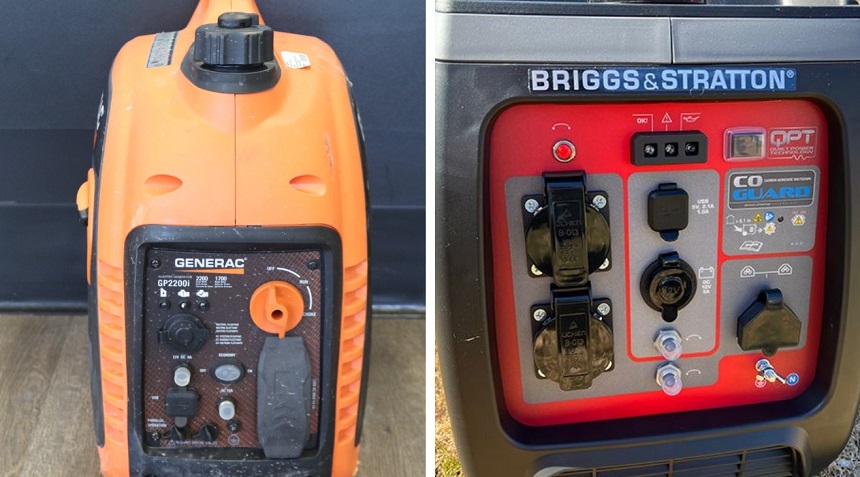
There’s not much to separate the two generator’s control panels. However, the outlets provided are a different matter. Some notable inclusions in the Generac generator include one USB port, one 12-volt DC port, and one 120V outlet.
It’s counterpart, the Briggs & Stratton model, offers two 230V outlets, which may be better suited to more powerful appliances. There’s also a 12V DC outlet and dual USB charging ports.
Both models are fairly easy to use, with similar levels of maintenance required. They also start up fairly easily, especially if you have the start knob in the right position. Overall, either option should be pretty intuitive, even for first-time generator users.
As for the noise levels, the protective enclosures in both generators help keep noise at a minimum. You can even reduce the noise further by activating the Quiet Power Technology in the Briggs and Stratton model or the economy mode in the Generac Generator. Overall, either option shouldn’t cause much of a ruckus when you have it running on your camping ground.
The portability has to go to the Generac model. It’s slightly smaller and lighter despite having a larger fuel tank. Consequently, it should be easier to pack and move around even if the difference is only a few pounds. That said, the Briggs & Stratton model is still quite portable, and if you don’t mind the four or five extra pounds there’s buying, it shouldn’t be a problem.
As for the durability and warranty, you may be better served by the Briggs & Stratton model if you want more protection for your purchase. You get a three-year warranty no matter how you use the device. Conversely, buyers of the Generac 7117 Gp2200I get two-year coverage for residential use, which drops to a single year of coverage for commercial use.
The price is pretty comparable for both inverter generators, although you may have to pay a few more dollars for the Generac model. As such, if you’re looking to save as much as possible, the Briggs & Stratton generator may be the obvious choice.
As per the Generac vs Briggs and Stratton generator review above, there are advantages to each option. For instance, the Generac 7117 Gp2200I may be the obvious choice if you want a longer runtime. The Generac also has the advantage in portability. Conversely, the Briggs & Stratton has more safety features, better warranty coverage, and puts out slightly more power. With that summary, you should find it easier to choose between the two.





